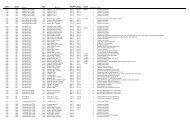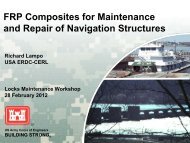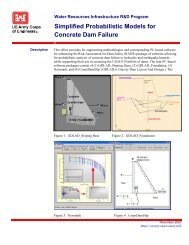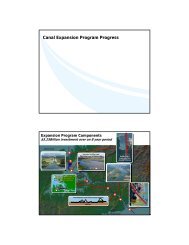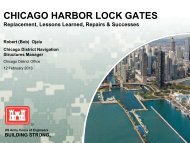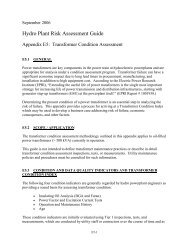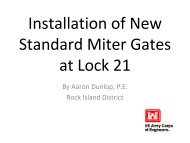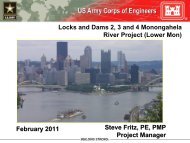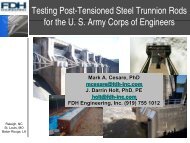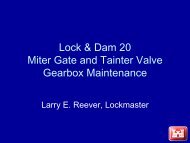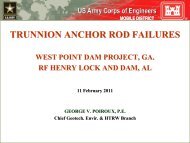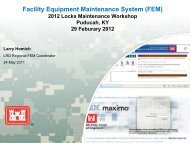Hydro Plant Risk Assessment Guide
Hydro Plant Risk Assessment Guide
Hydro Plant Risk Assessment Guide
You also want an ePaper? Increase the reach of your titles
YUMPU automatically turns print PDFs into web optimized ePapers that Google loves.
• Miscellaneous Damage or Other Conditions<br />
Test T2.1.1: Gates – Corrosion<br />
Corrosion typically causes the most damage to emergency closure gates. Special attention<br />
should be paid to critical areas such as welds, member interfaces, and connectors. Corrosion<br />
nodes should be chipped off to reveal the true extent of metal deterioration.<br />
Table 11 – Corrosion<br />
Results<br />
Good – Corrosion has not caused significant loss of cross-sectional<br />
area for structural members, corrosion buildup has not caused<br />
separation in adjacent members, localized corrosion has not reduced<br />
weld areas significantly, protective coatings in good condition, little<br />
or no cavitation.<br />
Moderate – Small amounts of cross-sectional area has been lost in<br />
some members, there is isolated plate separation caused by<br />
corrosion, some pitting, some weld area reduction in some welds,<br />
protective coating in fair condition, moderate cavitation.<br />
Severe – Significant cross-sectional area loss in critical members,<br />
widespread plate and/or member separation, significant weld size<br />
loss due to corrosion, significant pitting protective coating in poor<br />
condition, severe cavitation damage.<br />
Adjustment to<br />
Condition Index Score<br />
Add 1.0<br />
No Change<br />
Subtract 1.0<br />
Test T2.1.2: Gates – Yielding, Fracture, Fatigue, and Fabrication Discontinuities<br />
Yielding and fracture of structural members and weldments can compromise structural integrity<br />
and deserve special attention. They can occur from a variety of causes including, but not limited<br />
to:<br />
• Impact<br />
• Fatigue loading<br />
• Material defect<br />
• Design overload<br />
Fractures usually occur where there are local stress raisers. This occurs where there is a local<br />
geometry change. Examples of this are bolt/rivet holes, sharp inside corners, corrosion pits, and<br />
weldments. Cracking of weldments or base metals is particularly problematic where thick<br />
members are welded together or there are dimensioning errors. Improper welding techniques<br />
and welding in an inaccessible area can also lead to problematic discontinuities. Welding<br />
discontinuities take many forms and are usually identified by visual inspection. Visual<br />
inspection however cannot locate many weld discontinuities such as incomplete joint<br />
penetration. Non-destructive testing on welds is the best way to determine weld condition.<br />
E11-15



